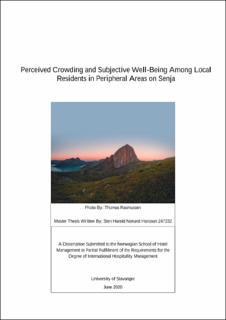| dc.contributor.advisor | Øystein, Jensen | |
| dc.contributor.author | Hansson, Sten Harald Norund | |
| dc.coverage.spatial | Norway, Senja | en_US |
| dc.date.accessioned | 2020-09-21T08:33:28Z | |
| dc.date.available | 2020-09-21T08:33:28Z | |
| dc.date.issued | 2020-06 | |
| dc.identifier.uri | https://hdl.handle.net/11250/2678684 | |
| dc.description | Master's thesis in International hospitality management | en_US |
| dc.description.abstract | Percived crowding as a result of tourism is a growing phenomenon in small communities in Norway. The purpose of this research is to identify the effects of perceived crowding on the subjective well-being of local inhabitants in peripheral areas on Senja. Determining how crowding affects the subjective well-being of local residents could help both tourism developers and local governmen to reduce the potential negative effects of tourism. It could also help the local population understand what effect crowding has on the individual.
The study took place in three carefully chosen locations on Senja where the number of visitors outnumbers the number of residents during the summer season. Data was collected through in-depth interviews of 12 local inhabitants. Due to the Covid-19 situation, the data was collected through phone interviews. The interview guide was structured according to Castillo-Montoya’s (2016) four phase process. To measure the quality of life among the local inhabitants I emplyed an adapted version of Watson, Clark, and Tellegen´s (1988) positive and negative affect scale (PANAS). To measure the local inhabitants’ overall satisfaction with life, Diener and Pavot´s (2009) SWLS scales were adapted into open-ended interview questions. To establish a group standard for determining the perception of crowding among the informants, Shelby and Heberline’s (1984) measurement tool was utilized.
Impacts of tourism were identified and to be able to explain the effects of these impacts, they were placed in the World Tourism Organization’s (1998) carrying capacity model. By structuring the impacts this way, an overview of what impacts of tourism were fully or in part affecting the subjective well-being of the participants of the study was created. After the impacts were explained, the concrete effects of crowding were identified and discussed in relation to the self-reported life satisfaction and quality of life of the interview subjects. Which lead to the conclusion that for the informants in the present study, perceived crowding lead to a short-term decrease in hedonic aspects of their subjective well-being. | en_US |
| dc.language.iso | eng | en_US |
| dc.publisher | University of Stavanger, Norway | en_US |
| dc.relation.ispartofseries | Masteroppgave/UIS-SV-NHS/2020; | |
| dc.rights | Navngivelse 4.0 Internasjonal | * |
| dc.rights.uri | http://creativecommons.org/licenses/by/4.0/deed.no | * |
| dc.subject | hotelladministrasjon | en_US |
| dc.subject | reiselivsadministrasjon | en_US |
| dc.subject | crowding | en_US |
| dc.subject | subjective well-being | en_US |
| dc.subject | turisme | en_US |
| dc.title | Perceived Crowding and Subjective Well-Being Among Local Residents in Peripheral Areas on Senja | en_US |
| dc.type | Master thesis | en_US |
| dc.subject.nsi | VDP::Social science: 200::Economics: 210::Business: 213 | en_US |

